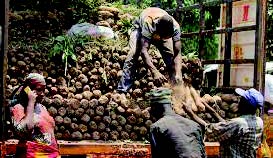
Stephen Ayefigo’s friends woke him up in the wee hours of that fateful Saturday to take cover at a nearby shed when the rain started. By the time he picked up his partially soaked cover cloth and mat, more than a dozen of people had rushed to occupy the benches used by the market women at the vehicle terminal popularly called Tema Station. For nearly five hours, Stephen stood as the heavens spewed cold breeze amidst thunder and lightning. The little money he made from carting supplies of tomato sellers throughout the week went missing in the process.
Tema station is one of the informal settlements in Accra. It welcomes migrants who often do not have family members in the capital city of Ghana. Accra houses 11 of the 23 slums in Ghana, which include Akwatia line and Old Fadama. While Stephen and his friends sleep in the open spaces at the vehicle terminal, others live in kiosks and wooden structures under insanitary conditions without basic social amenities. “I would not have come to Accra to go through this ordeal if my village had work opportunities to earn me a living,” Stephen told the Ghana News Agency (GNA).
According to Ghana’s 2022 Voluntary National Review Report on the Sustainable Development Goals (SDG) implementation, the number of people living in slums increased from 5.5 million in 2017 to 8.8 million in 2020. It is not surprising that the recent 2021 housing and population census showed that the population of Greater Accra and Ashanti regions alone, is nearing 12 million.
Stephen, 20, hails from Kurugu, a community, in the Kasana-Nankana West district of the Upper East Region with a population of about 2,800 according to the 2021 population and housing census. The main occupation of most community members is farming and basket weaving. Farming in Kurugu is rain fed – usually from June to October each year. Stephen says in the whole 12 months in the year, only five months is used for farming activities. In the last few decades, we have observed a reduction in the period for farming in the north of Ghana to about four months, saddled with intermittent drought and flooding which are key impacts of the climate crisis.
“We thought it wise to find other opportunities elsewhere. Even, access to water to be used for domestic chores and to bath is a big challenge, because the whole area becomes dry,” he said. The thinking of Stephen is synonymous with a popular Ghanaian phrase, “If there are many towns, it is not advisable to stay long at one place and disgrace yourself.” He is just one of seven out of every 10 persons from his community, Kurugu, who will move to cities in the south for greener pastures.
There are many Stephens from North-East, Northern, Savannah, and Upper East and West regions that are also compelled to migrate due to the impact of the climate crisis. Their respective regions are experiencing temperature rise and drought resulting in low yields and even loss of livelihood of parents. Usually, these migrants engage in head pottery, trader assistantship, collection of scrap metals/electrical and electronics equipment and carting food and other supplies. Interestingly, the Northern regions have one third of Ghana’s land mass, but Accra with its smallest land size is recipient of people from places with vast land. As noted by Djongon, Jacques in his research titled, “The plight of Female head-porters in Accra, seeking employment is the most important reason for migrating, which is line with the importance of ‘money’ being economic empowerment, particularly for people of low economic status. Professor Samuel Kobina Annim, Government Statistician, at a recent breakfast meeting with selected journalists ahead the Ghana Urban Forum 2022, questioned if the city is prepared for more people with its limited social amenities, housing, and the same land size. He says the data shows that while the population is growing geometrically, employment opportunities remain limited, compelling many young people in rural areas to migrate.
At Kurugu, Mr Yakubu Asaah Adamu, an opinion leader and a teacher says although it is not a new phenomenon, the rate of migration is at its all-time highest. During the dry season only, the vulnerable group made up of aged and children are left behind in the village. “I feel bad and sad about the situation. However, I am unable to go beyond a certain limit. People who are rich and can cause a change seem unconcerned, and there seems to be no plan to turn things around.
There is no blink of hope in our situation,” he said. “We have the right to access portable water, roads, and other opportunities. But who do we demand them from? The local authorities are not responsive. It is like those of us in the rural areas have been neglected.” He says the poverty cycle continues because the young girls mostly return from their exploit to the community with babies. They are usually left behind for their parents to nature. Ghana faces additional challenges due to the country’s high rate of urbanization and relatively large population of migrants from rural agricultural livelihoods to urban centers, a World Bank country report has revealed
These challenges are compounded by climate stressors such as floods and droughts that are increasingly putting pressure on service delivery, adaptation needs and financing. A glimpse of hope or bleak future Successive governments and development partners have made some efforts over the years to support, but the challenges persist.
Dr Shaibu Baanni Azumah, a Climate Researcher, is of the view that government initiatives and projects including the erstwhile Savannah Accelerated Development Authority, the Northern Development Authority, and the One Village one Dam project had largely failed due to its implementation approach. “The modern paradigm is participatory approach, which involves co-creation and implementation of solutions with the locals,” he told the GNA.
“To reduce or stop young ladies from moving to the south of Ghana to engage in head pottering, the effective way is to engage the girls and find out their needs and to co-create lasting solutions with them. It will be out of place to put them through catering or seamstress training because they probably, will earn more with other trades than the new skills that is forced on them.” He says the gains made by some of the interventions introduced by development partners to support local communities could not be sustained after the expiration of the projects. Dr Azumah who is also an Agricultural Economist says the government must commit funds to rehabilitating and building irrigation schemes to give farmers a dual cropping season in the north of Ghana. There must be a focus on value addition for agriculture produce in these rural communities as a means of creating jobs and boosting local economies. It is in line with the Food Agriculture Organisation calls for the need for leaders to create more employment opportunities for the youth in rural areas, by harnessing the potential of agriculture and rural livelihoods
“Fostering sustainable agriculture and rural development is essential to absorb the millions of youth looking for jobs,” said the Director General of the UN Food and Agriculture Organization José Graziano da Silva during a joint African Union-European Union meeting hosted at FAO headquarters in Rome last June. “A sustainable world can only be achieved with the full engagement of young people.
They must feel integrated and believe that a more peaceful and prosperous world is possible”. Pathways toward a new eco-social contract can be built on a new development model consisting of three key pillars: alternative economic approaches that centre environmental and social justice and rebalance state–market–society–nature relations, transformative social policies based on a fair fiscal contract, and reformed and strengthened multilateralism and solidarities, a United Nations Research Institute for Social Development recent report said. Some of the recommendations of FAO, UNRISD, and Dr Azumah resonate with Mr Adamu’s appeal to development partners to help Kurugu community with a water system dedicated to dry season farming to keep many of the youth active and productive.
Already, he says the Kurugu community working with Green Africa Youth Organization (GAYO), a youth-led gender-balanced organization have identified sustainable water for irrigation equipment as their key need. He says the increasing numbers of migrants will reduce if authorities and community members co-create opportunities and livelihood to offer them a lifeline in their communities.
Mr Dan Botwe, Minister of Local Government, Rural Development and Decentralisation shares the view of deliberately creating opportunities in rural areas to harness potentials, resources, and reduce migration to be able to live with impacts of the climate crisis.
BY ALBERT OPPONG-ANSAH STEPHEN




